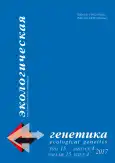Studying the biochemical function of the pea receptor-like kinases sym10, sym37 and k1, required for the legume-rhizobia symbiosis development
- Authors: Dolgikh E.A.1, Kirienko A.N.1, Kovaleva O.D.1, Tikhonovich I.A.1
-
Affiliations:
- All-Russian Research Institute for Agricultural Microbiology
- Issue: Vol 15, No 4 (2017)
- Pages: 4-12
- Section: Genetic basis of ecosystems evolution
- URL: https://journals.rcsi.science/ecolgenet/article/view/6164
- DOI: https://doi.org/10.17816/ecogen1544-12
- ID: 6164
Cite item
Full Text
Abstract
Background. Rhizobial Nod factors (NFs), the key regulators of legume-rhizobia symbiosis, act in low concentrations and their biological activity depends on structural features, that suggests the presence of specific receptors in plants. Putative receptors, LysM-receptor-like kinases (LysM-RLKs), were found in model legumes L. japonicus and M. truncatula. However, binding capacity with NFs was only studied for L. japonicus LysM-RLKs. In pea a few candidates for NF receptors like Sym10, Sym37 and K1 were found. Analysis of mutants revealed the importance of these proteins for symbiosis development. However, the biochemical function of these receptors has not been studied.
Materials and methods. Sequences encoding extracellular domains (ECDs) of LysM-RLKs Sym10, Sym37, and K1 were cloned in the pRSETa vector. Constructs were introduced in E. coli strain C41 to produce proteins with His6 residues on either the amino or carboxyl terminus. Protein purification was carried out using metal chelate affinity chromatography. The binding capacity with ligand was evaluated using ProteonXPR36 biosensor.
Results. To study binding capacity with NFs, we have developed approaches for the synthesis of LysM-RLK Sym10, Sym37 and K1 in soluble form in heterologous system. The high level of protein synthesis was achieved at +28 °C using 0,5 mM IPTG in 2-16 hours. Analysis of binding capacity of ECDs with NFs revealed the low affinity using the surface plasmon resonance.
Conclusion. The possibility of recombinant receptor synthesis in soluble state in E. coli at high level was demonstrated. Analysis of binding capacity with NFs showed the potential interaction, but with low affinity.
Full Text
##article.viewOnOriginalSite##About the authors
Elena A. Dolgikh
All-Russian Research Institute for Agricultural Microbiology
Author for correspondence.
Email: dol2helen@yahoo.com
ORCID iD: 0000-0003-3433-2102
SPIN-code: 4453-2060
Group leader, Laboratory of molecular and cell biology
Russian Federation, 3, Podbelsky highway, Pushkin, Saint-Petersburg, 196608Anna N. Kirienko
All-Russian Research Institute for Agricultural Microbiology
Email: kirienkoann@yandex.ru
Laboratory of molecular and cell biology
Russian Federation, 3, Podbelsky highway, Pushkin, Saint-Petersburg, 196608Oksana D. Kovaleva
All-Russian Research Institute for Agricultural Microbiology
Email: meriones@list.ru
PhD student, Laboratory of molecular and cell biology
Russian Federation, 3, Podbelsky highway, Pushkin, Saint-Petersburg, 196608Igor A. Tikhonovich
All-Russian Research Institute for Agricultural Microbiology
Email: arriam2008@yandex.ru
Professor, Director
Russian Federation, 3, Podbelsky highway, Pushkin, Saint-Petersburg, 196608References
- Madsen EB, Madsen LH, Radutoiu S, et al. A receptor kinase gene of the LysM type is involved in legume perception of rhizobial signals. Nature. 2003;425:637-640. doi: 10.1038/nature02045.
- Radutoiu S, Madsen LH, Madsen EB, et al. Plant recognition of symbiotic bacteria requires two LysM receptor-like kinases. Nature. 2003;425:569-570. doi: 10.1038/nature02039.
- Broghammer A, Krusell L, Blaise M, et al. Legume receptors perceive the rhizobial lipochitin oligosaccharide signal molecules by direct binding. Proc Natl Acad Sci USA. 2012;109(34):13859-13864. doi: 10.1073/pnas.1205171109.
- Mulder L, Lefebvre B, Cullimore J, Imberty A. LysM domains of Medicago truncatula NFP protein involved in Nod factor perception. Glycosylation state, molecular modeling and docking of chitooligosaccharides and Nod factors. Glycobiology. 2006;16(9):801-809. doi: 10.1093/glycob/cwl006.
- Lefebvre B, Klaus-Heisen D, Pietraszewska-Bogiel A, et al. Role of N-glycosylation sites and CXC motifs in trafficking of medicago truncatula Nod factor perception protein to plasma membrane. J Biol Chem. 2012;287(14):10812-10823. doi: 10.1074/jbc.M111.281634.
- Fliegmann J, Canova S, Lachaud C, et al. Lipo-chitooligosaccharidic symbiotic signals are recognized by LysM receptor-like kinase LYR3 in the legume Medicago. ACS Chemical Biology. 2013;8 (9):1900-1906. doi: 10.1021/cb400369u.
- Malkov N, Fliegmann J, Rosenberg C, et al. Molecular basis of lipo-chitooligosaccharide recognition by the lysin motif receptor-like kinase LYR3 in legumes. Biochem J. 2016;473:1369-1378. doi: 10.1042/BCJ20160073.
- Zhukov V, Radutoiu S, Madsen LH, et al. The Pea Sym37 receptor kinase gene controls infection-thread initiation and nodule development. Molecular Plant-Microbe Interactions. 2008;21(12):1600-1608. doi: 10.1094/MPMI-21-12-1600.
- Liu T, Liu Z, Song C, et al. Chitin-induced dimerization activates a plant immune receptor. Science. 2012;336(6085):1160-1164. doi: 10.1126/science.1218867.
- Hooykaas PJJ, Snidewint FGM, Schilperoort RA. Identification of the Sym plasmid of Rhizobium leguminosarumstrain 1001 and its transfer to and expression in other Rhizobia and Agrobacterium tumefaciens. Plasmid. 1982;8:73-82. doi: 10.1016/0147-619x(82)90042-7.
- Downie JA, Ma QS, Knight CD, et al. Cloning of the symbiotic region of Rhizobium leguminosarum: the nodulation genes are between the nitrogenase genes and a nifA-like gene. EMBO J. 1983;2(6):947-952.
- Spaink HPD, Sheeley M, van Brussel AAN, et al. A novel highly unsaturated fatty acid moiety of lipo-oligosaccharide signals determines host specificity of Rhizobium. Nature. 1991;354(6349):125-130. doi: 10.1038/354125a0.
- Duc G, Messager A. Mutagenesis of pea (Pisum sativum L.) and the isolation of mutants for nodulation and nitrogen fixation. Plant Sci. 1989;60:207-213. doi: 10.1016/0168-9452(89)90168-4.
- van Brussel AAN, Tak T, Wetselaar A, et al. Small leguminosae as test plants for nodulation of Rhizobium leguminosarum and other rhizobia and agrobacteria harbouring a leguminosarum sym-plasmid. Plant Science Letters. 1982;27(3):317-325. doi: 10.1016/0304-4211(82)90134-1.
- Bertani G. Studies on lysogenesis. I. The mode of phage liberation by lysogenic Escherichia coli. J Bacteriol. 1951;62:293-300.
- Laemmli UK. Cleavage of structural proteins during the assembly of the head of bacteriophage T4. Nature. 1970;15:680-685. doi: 10.1038/227680a0.
- van Brussel AAN, Planque K, Quispel A. The wall of Rhizobium leguminosarum in bacteroid and free-living forms. J Gen Microbiol. 1977;101:51-56. doi: 10.1099/00221287-101-1-51.
- Miroux B, Walker JE. Over-production of proteins in Escherichia coli: mutant hosts that allow synthesis of some membrane proteins and globular proteins at high levels. J Mol Biol. 1996;260(3):289-98. doi: 10.1006/jmbi.1996.0399.
- Cao Y, Liang Y, Tanaka K, et al. The kinase LYK5 is a major chitin receptor in Arabidopsis and forms a chitin-induced complex with related kinase CERK1. eLife. 2014;3.e03766. doi: 10.7554/elife.03766.
Supplementary files











